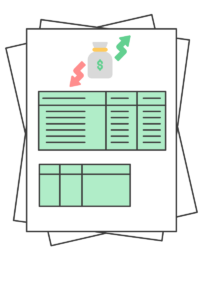When I started my career in accounting, I was an intern for a public accounting firm. I found an issue during one of my audit procedures and took it to my manager. She asked me if it had a P&L impact. I had no idea what she meant! And, I was just about to finish my accounting degree. Turns out, that’s what internships are for, learning. I learned that a P&L is a profit & loss statement, more commonly referred to as the income statement in accounting textbooks.
While seasoned accountants understand the mechanics of a profit & loss statement and why it is an important tool in managing your business, it’s important that business owners understand, too.

What Is a Profit & Loss Statement?
A Profit & Loss (P&L) statement, also known as an income statement, is a financial document that provides a snapshot of your business’s financial performance over a specific period. It’s like a financial report card that reveals whether your business is making a profit or incurring losses.
What Makes Up Your P&L
Revenue:
This is includes the income your business has earned during the specified period. It includes sales, fees, and any other sources of revenue. Keeping a close eye on revenue helps you gauge the effectiveness of your sales and marketing efforts.
Cost of Goods Sold (COGS):
COGS represents the direct costs associated with producing the goods or services you sell. Monitoring COGS is crucial for understanding how efficiently you’re using resources and managing production costs.
Gross Profit:
Gross profit is what remains when you subtract your COGS from your revenue. It indicates how well your core business operations are performing. No matter how well you manage your expenses, if you don’t have a healthy gross profit, your business can’t be profitable. Gross Profit margins are different based on industry, but is one of the most important performance indicators to monitor in your business.
Operating Expenses:
Operating expenses encompass all the costs not directly tied to production, such as rent, utilities, salaries, and marketing expenses. These are expenses that are a part of running any business, but can be managed to help maintain profitability.
Net Operating Income (or Loss):
After deducting operating expenses from gross profit, you’ll get to your Net Operating Income (or loss if it’s a negative number). The goal of every business should be to operate at a positive operating income over the long-term.
Other Income/Expenses:
Other Income and Expenses are non-recurring items, such as a one-time expense or unexpected income that is not from regular operations. This may be a gain on selling a piece of equipment, interest income on money you hold in the bank, or an unexpected expense related to a lawsuit. These show up “below the line”, because they don’t affect the ongoing operations of the business.
Net Income (or Loss):
Net Income is your bottom-line, after all Revenue, COGS, Expenses, and Other Income and Expenses are taken into account.
How to Use Your P&L:
You should use your P&L to help manage your business and make business decisions. Analyze for trends to determine how your business is performing and make adjustments based on your analysis. If your revenue is trending downward, look into what is causing the decrease. Have your marketing efforts stopped working? Did you lose a key salesperson? Has there been an economic downturn? Is it a short-term reduction or do you need to start making adjustments to your cos
ts to account for a longer-term downturn.
- Review your P&L compared to the same period during the prior year to see how your revenue is trending compared to last year. Are your expenses in line with the increase or decrease you’re seeing in revenue?
- Review the monthly activity over the prior 12 months (referred to as a Trailing 12-Month, or TTM) to see if there are trends that need to be addressed.
- Review key ratios. What is your gross margin percentage and how does it compare to last month, or last year? What is your net income percentage? What is your increase in revenue year-over-year? How does that compare to your increase in operating expenses?
Written By: Shauna Huntington
Posted in Accounting Solutions, General, Small Business Accounting


